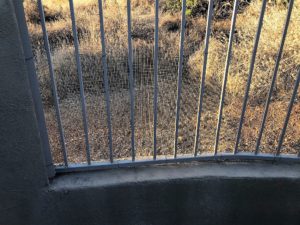Rattlesnakes are highly adaptable venomous snakes that live thoughout the continental United States. They are members of the Crotalidae family of venomous snakes which is a subfamily of vipers. Beside rattlesnakes, this group includes water moccasins and copperheads. This group does not include coral, mamba or sea snakes which are part of the Elapidae family.
Vipers inject venom into prey through two large fangs that protrude from the upper jaw. The venom is a mix of toxins and enzymes that will immobilize the prey and destroy the tissue in the area of the bite which allows the venom to spread more quickly. It includes myotoxins, cytotoxins, neurotoxins, cardiotoxins and hemorrhagic toxins. The venom from rattlesnakes is the most toxic followed by venom from water moccasins and copperheads in that order. The snake controls how much venom is injected per strike. Young snakes tend to deliver their entire load of venom whereas mature snakes may not inject any venom at all. This is referred to as a ‘dry bite’.
Swelling, bruising and pain are the most common clinical signs of a snake bite. Dogs are often bit on the head or legs which is a good thing because the venom spreads more slowly from these areas when compared to the torso. Swelling develops quickly and may cause airway obstruction. Snake bites are very painful! Dogs will yelp, moan and cry if the affected area is touched. The venom also interferes with the victim’s ability to clot their blood. Bleeding from the nose, mouth and eyes as well as bloody urine or feces are common. If this isn’t bad enough, some rattlesnake venom contains neurotoxins. Dogs may suffer a variety of neurologic signs from difficulty walking to paralysis, seizures to coma.
The goal of treatment is to neutralize the venom with antivenom as soon as possible. Best outcomes occur when the antivenom is given within 4 hours of the bite. The antivenom is made of antibodies, either the entire IgG or fragments of IgG, given through an intravenous catheter. Again, time is of the essence. In addition, patients need fluid therapy to treat shock and strong pain management. Some patients may need blood transfusions if bleeding is severe. Unfortunately, even with aggressive therapy, some dogs will not make it. Pictured below is a dog who was bitten on the left side of the lip by a Western Diamondback Rattlesnake. Severe swelling was noted on the lip and neck. This dog was treated with ‘Rattler’ Antivenom. This is the only antivenon that has antibodies against the Mohave rattlesnake venom. The swelling started to recede within ten minutes of starting treatment and she made a complete recovery!
Prevention of snake bites:
- Snake Avoidance Training – In areas with a lot of indigenous venomous snakes, many dog training centers offer snake avoidance training. The dog is fitted with an electric (shock) collar then exposed to the snake that is either in a cage or wearing a hood to prevent a strike. When the dog smells the snake, they receive a small shock and are taken away from the snake. A few minutes later, the dog is exposed to the snake again. Most dogs, will freeze instantly and then leave the area. If they continue toward the snake, a stronger shock is administered until the dog gives up. This type of training works well for confident dogs but I do not recommend it for timid dogs.
- Crotalus Atrox Vaccine (Rattlesnake Vaccine) – Red Rock Biologics produces a vaccine for rattlesnake bites. Unfortunately, there is a lot of confusion surrounding this product. It is not a true vaccine that protects the pet from disease like the rabies vaccine. Instead, the crotalus atrox vaccine gives the dog more time to get treatment. The dog pictured above had the crotalus atrox vaccine a month and a half before the bite occurred. Most of the dogs I vaccinate live on ranches or go hiking and camping in remote areas where it may take hours to get treatment. Unfortunately, I have seen some bad reactions in my patients from this vaccine. Also, this vaccine stimulates antibodies against the Western Diamondback rattlesnake. Although the antibodies cross react with some other rattlesnakes but does not stimulate antibodies against the neurotoxin in Mohave rattlesnakes. Please discuss the pros and cons with a veterinarian before use.
- Prevent Snake Exposure – Snakes follow their noses to prey. Keep rats, mice and other rodents away from homes by making the environment less inviting. Keep citrus picked up and pet food indoors. Install snake fencing to keep reptiles out. Pictured below are some ideas to help you snake proof your yard. The first one if a gate showing the gate resting on pavers without a gap. The gate actually rubs the pavers when opened. The screen extends on both sides to cover the gaps that occur. The second image shows screen wired to a combination block and iron fence. The screen extends to the block without any gaps. The brush has been removed from both sides of the fence to make the area less hospitable for rodents and snakes. It also provides a defensible space in case of fire. Drains in the wall need to be covered with screen as well.
Source:
-Rothrock, Kari. ‘Snake Evenomation, Crotalid’. VIN Associate Database, last updated 10/26/2017.




Can I publish a research paper to this blog?
Please upload your paper. I will read it and then make a decision.